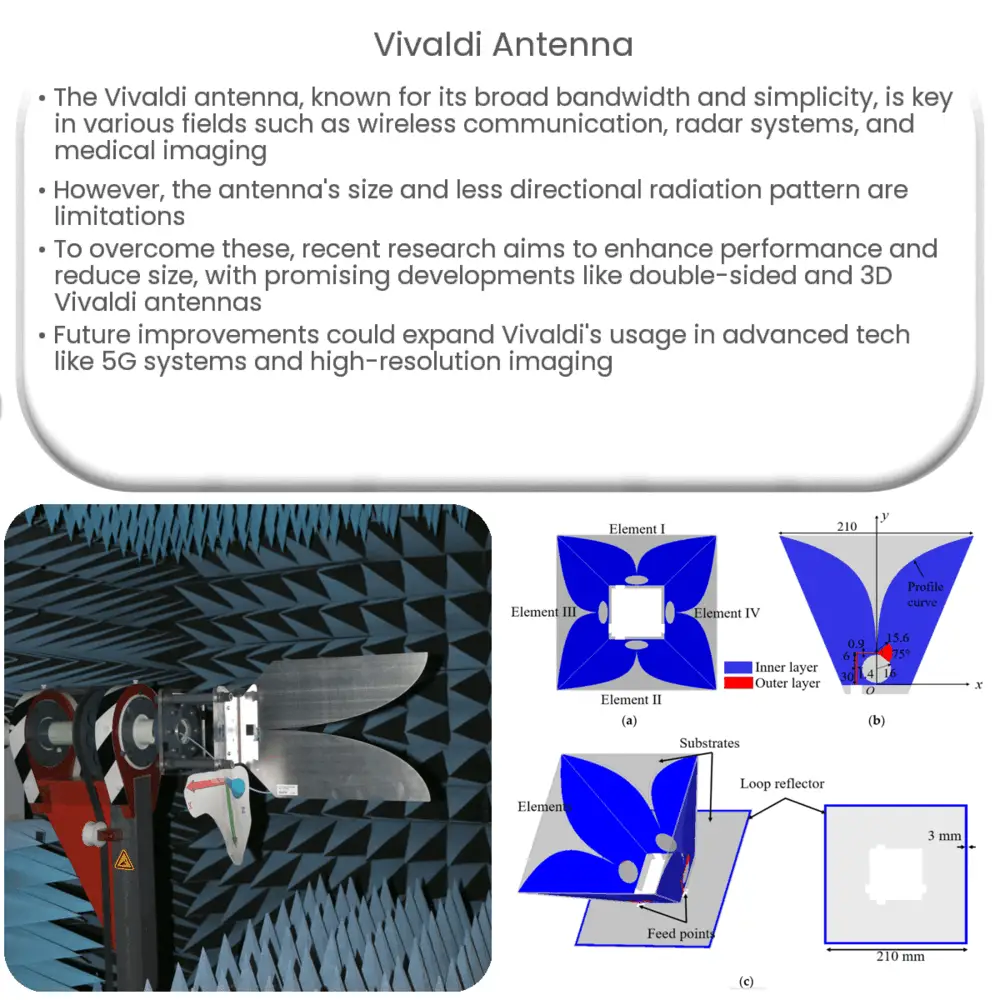Explore the design, operation, applications, and future of Vivaldi antennas, a key tool in advanced wireless communication.

Introduction to Vivaldi Antenna
The Vivaldi Antenna, often referred to as a “tapered slot antenna”, represents a significant advancement in the field of antenna technology. This innovative design, named after the famous Italian composer Antonio Vivaldi, is known for its broad bandwidth and simple structure, making it an attractive choice for various applications.
Design and Operation
The unique design of a Vivaldi antenna consists of a tapered slot on a dielectric substrate. This tapering can be exponential, linear, or a combination of both, depending on the specific requirements of the antenna. The tapering is integral to the antenna’s operation, as it provides the broad bandwidth that these antennas are known for. The operation of a Vivaldi antenna involves the transmission of electromagnetic waves along the tapered slot, which are then radiated outwards.
Applications of Vivaldi Antennas
- Wireless Communication: The broad bandwidth of Vivaldi antennas makes them ideal for applications in wireless communication. They can be used in both transmission and reception of signals across a wide range of frequencies.
- Radar Systems: Vivaldi antennas are often used in radar systems, particularly in ground-penetrating radars, where a broad frequency range is necessary to achieve the desired resolution.
- Medical Imaging: Due to their ability to operate at various frequencies, Vivaldi antennas can also be utilized in medical imaging applications, such as in microwave imaging systems.
Advantages and Disadvantages of Vivaldi Antennas
One of the main advantages of Vivaldi antennas is their wide bandwidth. This allows them to operate over a large frequency range, making them versatile for numerous applications. They also have a relatively simple design and construction process, which can reduce manufacturing costs.
On the other hand, a potential drawback of these antennas is their size. Given that the size of an antenna is inversely proportional to its operational frequency, Vivaldi antennas can become quite large when operating at lower frequencies. This can limit their use in applications where space is a constraint.
Another disadvantage is their radiation pattern, which can be less directional compared to other types of antennas. This might lead to a decrease in performance in certain scenarios where a more focused radiation pattern is required.
Recent Developments
In recent years, there have been numerous research efforts directed towards improving the performance and reducing the size of Vivaldi antennas. These have resulted in new designs such as the double-sided Vivaldi antenna and the 3D Vivaldi antenna, which provide enhanced gain and directivity.
Advancements in material science have also led to the use of innovative substrates in the construction of Vivaldi antennas, contributing to reduced size and improved performance. The integration of metamaterials, for instance, is a promising field of study in this regard.
Future Prospects
As we continue to push the boundaries of wireless communication, the need for efficient, high-performance antennas is greater than ever. The Vivaldi antenna, with its broad bandwidth and simple structure, is poised to play a crucial role in this arena.
Future research and advancements in this field are likely to focus on further refining the design of Vivaldi antennas to enhance their performance, reduce their size, and increase their directivity. These improvements could pave the way for their use in a wider range of applications, including 5G and beyond wireless communication systems, high-resolution radar systems, and advanced medical imaging technologies.
Conclusion
In conclusion, the Vivaldi antenna is a versatile and powerful tool in the field of antenna technology. Its broad bandwidth, simple structure, and wide range of applications make it an integral part of numerous technological systems. Despite some challenges, ongoing research and development promise exciting advancements and increased utilization of this antenna type. As the demand for effective wireless communication continues to grow, so too will the importance and relevance of the Vivaldi antenna.

